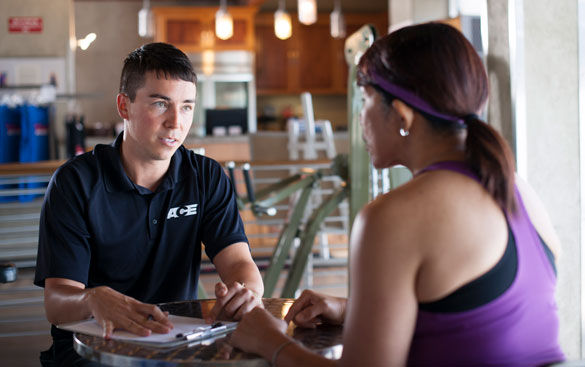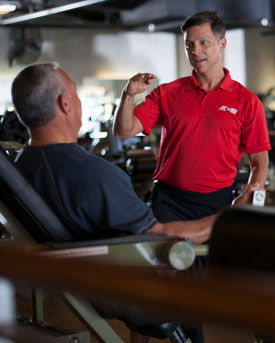
As every health and fitness professional knows, there is no such thing as a perfect client, one who shows up at the gym fired up to work hard, day in and day out, without fail. People take breaks from their fitness routines, both planned and unplanned, over the course of their lives, and accommodating those lapses is part of what makes someone successful over the long term.
The potential reasons for prolonged absences from a physically active lifestyle are endless, ranging from illness and injury to bad weather and lack of results. It is important to remember that, like all other elements of programming, these breaks—the reason and the duration—must be viewed on a case-by-case basis so you can provide your client with an individualized approach to making a safe and effective return to exercise.
Consider the following scenarios:
Tom is a 54-year-old avid mountain biker living in New England. For three or four months every year, he is unable to take part in his favorite activity and struggles to maintain his fitness level when the weather turns cold.
Tanya, a 33-year-old mother of two, takes part in four small-group training sessions per week at her gym, but has been absent for the past eight weeks after a nagging shoulder injury disrupted her routine.
Dylan is a 19-year-old college athlete and a devoted personal-training client. He missed three months of training after contracting mono and his fitness level has dropped considerably.
Mark is a 43-year-old lawyer who has been absent for about two months because he was overloaded at work and just couldn’t find time to get a workout in.
Finally, Randall, a 72-year-old retiree, is a relative newcomer to the fitness facility who stopped coming in about three weeks ago after becoming disillusioned with his lack of results.
These situations are all vastly different, from the individuals’ reasons for their absences to the duration of their downtime and the obstacles to a smooth return to a fitness routine.
In many cases, clients coming back from a prolonged break want to jump right back in where they left off. Unfortunately, few maxims hold as much truth in the fitness world as “use it or lose it.” It is up to you to determine the best course of action to get your client back on track and recommitted to the program.
The Reversibility Principle
The reversibility principle is one of four general training principles that all health and fitness professionals should know. Along with the principles of specificity, diminishing returns, and overload and progression, an understanding of reversibility is essential to developing the safest and most effective training programs or classes. According to ACE’s Essentials of Exercise Science for Fitness Professionals, “The principle of reversibility pertains to the losses in function experienced after the cessation of a training program. Regardless of the gains in fitness achieved through a regular exercise program, those improvements will be reversed to pre-training levels and may ultimately decrease to a point that meets only the demands of daily use.”
This principle reinforces the importance of clients making true, ongoing lifestyle change rather than using training as a means of obtaining some short-term objective.
The All-Important “Why?”
The first and most important question to ask any client coming back to your facility after a prolonged absence is “Why?” The answer should dictate all subsequent discussion and planning. For example, in lawyer Mark’s case, his time off was due to a simple lack of time. Therefore, no underlying illness or injury needs to be addressed upon his return. Same goes for Tom, the mountain biker, who probably just requires an indoor workout plan that keeps him fit during the winter so that he doesn’t struggle so much when he gets back on his bike in the spring.
For Tanya, who is coming back from a shoulder injury, a lot more questions need to be asked and answered. What was the extent of her injury? Where does she stand in the healing process and what are her limitations? Has she seen a doctor or physical therapist and what are their instructions? Similar questions must be asked of Dylan, who recently battled mono. How long was he sick? How much of his strength or cardio endurance has he lost? What is his current exercise capacity?
Finally, for Randall, who skipped a few weeks after getting frustrated with his lack of results, there are a host of other questions to be considered. What were his initial goals and should any of them be reconsidered? What can you change about his program to make it more interesting?
Clearly, one size never fits all.
Taking an Individualized Approach
“A return to physical activity after an extended break can really be quite complex,” says Lance Dalleck, Ph.D., assistant professor of exercise and sport science at Western State Colorado University. Depending on the person’s goals or performance objectives, there are countless things to keep in mind. “Consider an athlete who took six weeks off and now needs to gear up for competition,” says Dalleck. “If the person was quite active prior to the break—perhaps even near the threshold for overtraining—he or she might actually benefit from the time off.” Of course, that’s not going to be the case for most clients.
Dr. Dalleck reminds us of the importance of discussing a person’s training history, as a returning athlete is in a completely different situation than a previously sedentary person who worked out for only a few months and then got derailed. There are just so many variables to work through, including the amount of time off, the extent of the detraining, the person’s history with exercise, the reason for the break and the age of the individual, that it can become overwhelming.
How to Prepare Clients for Time Off
In an ideal situation, a client will know in advance when he or she will need to take an extended break. Clients who will experience disruptions to their routines because of work-related commitments or weather-related breaks from their favorite activities can typically see those issues on the horizon. Of course, clients who are injured or fall ill are not so lucky.

If a prolonged absence can be anticipated, there are some things a client can do to stave off the reversibility principle. They may not be able to completely avoid drops in their fitness levels, but they may be able to take steps to maintain previously acquired gains.
Clients should try to continue any nutrition plan as best they can. Eating right, and avoiding weight gain, can make a return to exercise considerably easier.
Encourage your clients to try to find (or make) time to sneak in short bouts of exercise during their day. For example, 10 or 15 minutes of body-weight exercise or fast walking will keep the muscles engaged. Pete McCall suggests that clients, “Just do something!” Remember, some activity is always better than none, so have clients reduce their sedentary behaviors as much as possible.
Dr. Porcari reminds us that performing a resistance-training program once a week can help clients maintain a majority of previously made strength gains. When it comes to cardiorespiratory training, Dr. Porcari recommends focusing on intensity if your time is limited. Also, he says that trainers should teach their clients to “value the routine.” In other words, help them find time to maintain some element of their routine even when they’re “on a break.”
Dr. Dalleck echoes the idea of focusing on intensity, but extends it to include resistance training as well. “Periodically—once or twice a week—do a high-intensity interval training (HIIT) protocol,” he says, “as this can be effective at maintaining muscular strength, fitness and power.”
Pete McCall, faculty in the Exercise Science Department at Mesa College and ACE Certified Personal Trainer, tries to simplify things. “These clients simply cannot pick up where they left off,” he says, “as this is a surefire recipe for injuries and setbacks. It’s important that you explain to them that by taking a break they removed the regular application of stress, so they will need an adaptation period to adjust to the demand again.”
Taking more than a few weeks off creates a detraining effect. For that reason, McCall suggests treating clients returning from extended breaks as if they are newcomers.
You may not have to begin with novice-level exercises as if the person had never worked out before, but you do want to start from scratch in terms of reassessing the client with movement screens and postural assessments. McCall recommends trainers and coaches revisit the ACE Integrated Fitness Training® (ACE IFT®) Model in the early sessions with these returning clients. For example, if you have a client who was in the Load Training phase prior to an absence, meaning that he or she was working with external loads during strength-training sessions, you may need to regress him or her to the Movement Training phase. That way, the client can relearn movements using his or her body weight without the added injury risk that comes with external loads.
Dr. Dalleck echoes this sentiment. “Tell clients to give themselves time,” he says. “A person who has been inactive for a period of time can move to full-volume, full-intensity workouts relatively smoothly if they’re careful at the outset.”
John Porcari, Ph.D., professor in the Department of Exercise and Sport Science and program director of the Clinical Exercise Physiology graduate program at the University of Wisconsin–La Crosse, feels that the main element to dial back is intensity, no matter if the client is an athlete, a fitness enthusiast or a relative newcomer. That said, duration and frequency must be scaled back as well, perhaps by 10 to 25 percent. “You must systematically increase time, distance and intensity,” says Dr. Porcari, “based on the responses of the individual.”
McCall stresses another element of training that is absolutely essential in this situation—the building and cultivating of a good rapport. Explain to your clients that breaks are an inevitable part of life, and that they need to have realistic expectations. “Tell clients that it’s not a failure,” he says. “Instead, emphasize to them that, while fitness may not have been a priority for a little while, we can figure out how to make it a priority again.”
A client who stopped exercising because he or she perceived a lack of results or just got bored needs to be approached a bit differently than one who has been absent for a physiological reason such as an injury or illness. In this case, you may have to use motivational interviewing and active listening to get to the core of why they quit working out—and why they had started exercising in the first place. It is up to you to help these clients rediscover what made them walk through those gym doors for the first time and then set some new objectives that match their current expectations, needs and desires.
Type of Exercise
Another consideration involves the type of physical activity, as some types are quicker to show the effects of detraining and therefore slower to rebound than others. Dr. Porcari states that avoiding orthopedic injuries should be the primary consideration.
“When it comes to resistance training, clients must recondition their muscles, joints and tendons to the stresses of exercise if they are going to avoid overuse injuries,” says Dr. Porcari. Unfortunately, overuse injuries often manifest over time, such as in the case of plantar fasciitis or patellofemoral pain syndrome, which means clients might not necessarily know they are overdoing it until symptoms begin to arise.
The cardiorespiratory system is not as much of a concern as the musculoskeletal system. As Dr. Porcari puts it, “If you work out ‘too hard’ during a cardio session, you’re just going to be more tired than usual. You’re going to recover, and it’s not as though you’re going to damage your heart or lungs in any way.” On the other hand, according to Dr. Dalleck, the body’s ability to generate energy can down-regulate rather quickly with inactivity, but will also rebound quickly. For that reason, you still need to begin slowly when it comes to cardiorespiratory exercise. Ease off on the duration/distance and pace and let the client work back up to his or her pre-break fitness level.
Sport-specific training is a distinct form of exercise. When working with athletes who are trying to get back into “game shape,” it’s important to note that technique and skill will not generally be impacted by detraining, as sport skills are typically developed over years of practice. Still, you must treat athletes as you would any other client in terms of helping them progress back to their prior level of fitness. In other words, athletes, even great ones, are not immune to the reversibility principle.
In Conclusion
Drs. Dalleck and Porcari both point out that there is scant research on the topic of reversibility and how to best ease someone back into their routine—and there is a clear reason for that. Every client has truly personalized reasons for taking a break, ranging from acute injury to simple lack of interest, and returns to the fitness facility with a number of other variables that must be carefully considered. Your job as a health and fitness professional is to examine why exercise became deprioritized in that person’s life and to help him or her figure out how to get back on track. You can only do that by establishing the rapport to examine the reasons for their lapse and then working together with the client to develop a new exercise program that is tailored to his or her current stage of readiness and fitness level. The initial goal should be to reestablish the habit and routine of being physical active.





 by
by 






